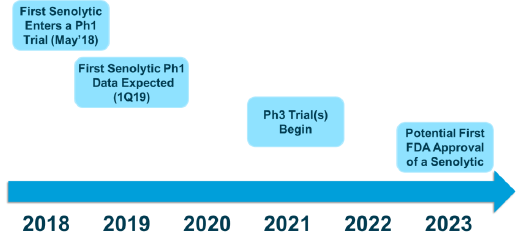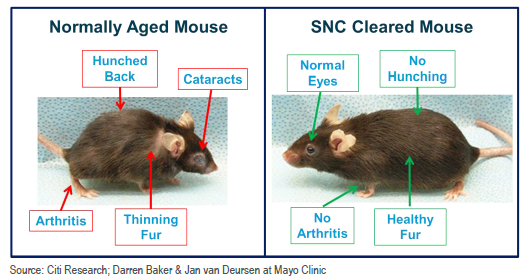From the ancient times when all the hope was put in the miraculous power of the Philosopher’s Stone or the Fountain of Youth, a lot of things have changed. Science and technologies don’t stay still, and nowadays remedies for increasing the life duration have all chances to enter the world market and change our lives forever. According to statistics, for today, people live longer, and the quality of life, in general, is better than several years before. However, it is evident that it’s not enough and nowadays the best scientists all over the globe are searching for the opportunity to maximally prolong our life or maybe even … make us immortal. Yes, it sounds as something unreal but actually, a range of attempts have been made already, and some of them gave promising results. Profound researches have helped scientists understand why we are growing old and “who” is responsible for it. Basing on this information, the anti-aging medicines are developing and may become one of the most significant breakthroughs in the world of medicine.
Prior attempts. Was everything in vain?
We have already mentioned at the beginning of the article that a range of prior attempts has already been performed. Were they all successful and which results they have brought to us? In the Biopharmaceutical industry several attempts to “catch the youthfulness” or at least to reach the maximal longevity have been performed.
Among them were such experiments as the activation of so-called sirtuin proteins (via resveratrol, a component found in red wine) and the enzyme telomerase (increasing healthy cell division by activating telomerase).
Taking into account that we are still getting older each day and all the talks about eternal youthfulness and immortality are perceived as crazy nonsense, it is easy to guess the result of these attempts. Nevertheless, if you for a moment thought that it was just the waste of time and money, you are entirely mistaken. Thanks to the results obtained, the science and technology that are necessary for the anti-aging medications creation has significantly advanced in recent years. It is a noticeable step in the direction of developing therapies capable of slowing/reversing or potentially preventing the onset of age-related diseases.
Nowadays the biotech companies are struggling with the old age and the diseases related to it by involving the newest technologies and innovations in the process. Two US companies, Unity Biotechnology and Calico, occupy the leading positions to date in the race for creating the anti-aging preparation. They are aimed at extending the human lifespan or in simple words, the period of our life without any age-related diseases. Among the most recent approaches offered by these companies to reach the goal is the elimination of the specific cell type found in our bodies and called “senescent cells.” According to the companies’ statements, these cells are the one who is “responsible” for the age-related diseases’ occurrence. Basing on these results, Unity Biotechnology currently is working on the new type of medications that are called “senolytics” and can eliminate the senescent cells while sparing the healthy tissues in our organism. Recently, these medications have been advanced in the clinical use by the Unity company for treatment the osteoarthritis of the knee – one of the most widespread age-related diseases for today. According to the statistical data, this disease affects more than fifteen million people in the United States. In the case, if the clinical trials are successful, the FDA can approve the medication, and it will be commercially available within the next five or six years.
What should we know about the senescent cells?
So, who are the senescent cells? Before blaming them for all the health problems occurring with age, let’s sort out what is their primary task in our organism as all the cells are there not for nothing. There are two major tasks for these guys in our bodies, and they are the following:
- The senescent cells induction is a kind of defense mechanism to prevent the development of cancer and other forms of cellular dysfunction. The mechanism of this work is quite simple – cells in our organism can stop their dividing (in other words – senescence) and thus, a “barrier” for the cancer cells development occurs.
- In addition to this, senescent cells produce and secrete a particular combination of pro-inflammatory proteins and growth factors. In their turn, these factors are also responsible for several tasks. They induce an inflammatory response that stimulates clearance in case if the tissue is damaged or is potentially cancerous. Also, these factors eliminate acute senescent cells when they did their job.
But… Unfortunately, in lots of cases, there is a “but” that spoils the whole picture. This case is not an exception, and while these cells should disappear when they performed the main task, sometimes they persist in the tissues of our organism. As a result of such a presence, chronic senescence occurs. According to the scientists’ researches, it is the main reason for the age-related diseases genesis. Among these diseases are:
- atherosclerosis (plaque growth in the artery walls);
- degeneration of retinal;
- arthritis;
- Alzheimer’s disease;
- fibrosis.
The flushing out of the senescent cells sounds like an attractive and promising therapeutic strategy.
Mice trials as the first step to success
Now we know “who” in our organism somehow or other is responsible for the onset of the age-related diseases. In the previous paragraph, we have claimed that the flushing out of the senescent cells can become an excellent therapeutic strategy, but here the next question arises – how to do this? For such purpose, scientists developed a special kind of medications that can selectively eliminate chronic senescent cells. Let’s puzzle out in the mechanism of their action:
- First of all, the normal cells receive a stress signal;
- After that, senescent cells form and accumulate in the tissues;
- As a result of such accumulation, pro-inflammatory factors recruit immune cells and fibroblasts, which cause tissue damage and disease;
- Then the senolytic treatment is applied and, as a result of the removal of senescent cells, normal tissue function is restored.
Of course, what theory without an experiment? In preclinical animal studies, scientists have achieved promising results. It was confirmed that the removal of senescent cells really could prevent the onset of age-related diseases like arthritis, cataracts, and kidney dysfunction. Researchers have performed a very demonstrative experiment with mice to test the theory in action. Two mice that were born in the same brood were monitored throughout their lifespan for the development of the age-related diseases. One of them (the left on the picture below) lived without any intervention from the pharmacological side. At the same time, another mouse (the right one) was treated with the senolytic agent to flush out the senolytic cells from the organism periodically. By the end of the studies, the mouse on the right appears visibly much younger, and none of the age-related diseases were noticed. A different situation was with the left mouse that lived without the intervention. Scientists observed such age-related disorders as cataracts and arthritis, as well as the hunched back, and thinning fur.
After this experiment, lots of high-profile papers appeared in the world known scientific journals. All the articles have reached the same conclusion – eliminating the senescent cells in the organism prevents the onset of the age-related diseases and restores normal tissue function.
Main challenges of the senolytic therapy for today
Of course, everything is not so simple as we want it to be, and some severe problems are on the way of senolytic therapy development for today. We have mentioned in the article that the central role of the senescent cells is cancer surveillance and wound healing. So, the critical questions for the scientists nowadays are:
- whether senolytic therapy can cause adverse effects that follow the removal of chronic senescent cells;
- whether the treatment can disrupt the development of the acute senescent cells that the organism still needs.
Another important question about “magical therapy” is about the correct dosage of senolytics. According to the researches, the accumulation of the senescent cells occurs slowly, so it will be logical to adopt the intermittent dosing. For example, medications can be taken once or twice a year or even less frequently depending on the indication of the target.
So now is time for the most exciting question – when? When will the senolytic therapy be approved? The first data from the Phase 1 trial is expected in the first quarter of 2019. If the experiment is successful, Phase 3 will start. If it also ends with success, the medication will be commercially available by the end of 2023. Science doesn’t stay still, and maybe in a few years, we will not even think about senility and age-related diseases. Longevity is slowly turning from the myth to reality.



Recent Comments